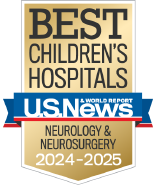Nazir's story
Nazir received the expert, holistic care he needed to correct a rare and complex skull condition called craniosynostosis.
 Our team of pediatric experts offers leading-edge diagnosis and treatment with the gentlest touch for children with craniosynostosis.
Our team of pediatric experts offers leading-edge diagnosis and treatment with the gentlest touch for children with craniosynostosis.
The cranium is the part of the skull that surrounds and protects the brain. The cranium of a very young child is made of bones that are loosely joined by sections of mutable fibrous material called sutures. As the baby ages, those skull bones normally move apart to make room for brain growth. Eventually, the sutures harden, fusing the skull bones together. If they harden too early, though, there will be insufficient room in the skull for the still-growing brain. This premature suture fusion, known as craniosynostosis (kray-nee-o-sin-os-TOE-sis), may result in harmful pressure on the brain and a distortion of the head’s normal shape.
At Lucile Packard Children's Hospital Stanford, our world-class team of pediatric neurosurgeons and craniofacial surgeons have decades of combined experience treating craniosynostosis in children. They deploy extensive 3-D virtual imaging and planning techniques to model abnormal areas and chart the best surgical route toward restoring the head’s normal shape. In many cases, endoscopic techniques allow doctors to forgo open surgery and work instead through tiny incisions in the scalp, reducing patient stress and recovery time.
Nazir received the expert, holistic care he needed to correct a rare and complex skull condition called craniosynostosis.
This dedicated craniosynostosis team is attentive to the sometimes-subtle symptoms of underlying or associated disorders and is equipped to address developmental, cognitive or psychological issues that may emerge with multisuture craniosynostosis. The team closely follows patients for years, routinely seeing them in the clinic until they are at least 8 years old. These rapidly evolving services, techniques and technologies make treatment of craniosynostosis more effective for young patients and less difficult for both them and their families.
Connect with us:
Download our App: